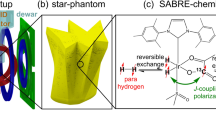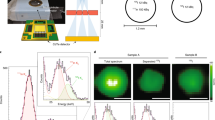Abstract
Magnetic resonance imaging (MRI) provides fine spatial resolution, spectral sensitivity and a rich variety of contrast mechanisms for diagnostic medical applications1,2. Nuclear imaging using γ-ray cameras offers the benefits of using small quantities of radioactive tracers that seek specific targets of interest within the body3. Here we describe an imaging and spectroscopic modality that combines favourable aspects of both approaches. Spatial information is encoded into the spin orientations of tiny amounts of a polarized radioactive tracer using pulses of both radio-frequency electromagnetic radiation and magnetic-field gradients, as in MRI. However, rather than detecting weak radio-frequency signals, imaging information is obtained through the detection of γ-rays. A single γ-ray detector can be used to acquire an image; no γ-ray camera is needed. We demonstrate the feasibility of our technique by producing images and spectra from a glass cell containing only about 4 × 1013 atoms (about 1 millicurie) of the metastable isomer 131mXe that were polarized using the laser technique of spin-exchange optical pumping4. If the cell had instead been filled with water and imaged using conventional MRI, then it would have contained more than 1024 water molecules. The high sensitivity of our modality expands the breadth of applications of magnetic resonance, and could lead to a new class of radioactive tracers.
This is a preview of subscription content, access via your institution
Access options
Subscribe to this journal
Receive 51 print issues and online access
$199.00 per year
only $3.90 per issue
Buy this article
- Purchase on Springer Link
- Instant access to full article PDF
Prices may be subject to local taxes which are calculated during checkout




Similar content being viewed by others
References
Lauterbur, P. C. Image formation by induced local interactions: examples employing nuclear magnetic resonance. Nature 242, 190–191 (1973)
Brown, R. W., Cheng, Y.-C. N., Haacke, E. M., Thompson, M. R. & Venkatesan, R. Magnetic Resonance Imaging: Physical Principles and Sequence Design (Wiley-Blackwell, 2014)
Cherry, S. R., Sorenson, J. A. & Phelps, M. E. Physics in Nuclear Medicine (Elsevier Saunders, 2012)
Walker, T. G. & Happer, W. Spin-exchange optical pumping of noble-gas nuclei. Rev. Mod. Phys. 69, 629–642 (1997)
Rabi, I. I., Zacharias, J. R., Millman, S. & Kusch, P. A new method of measuring nuclear magnetic moment. Phys. Rev. 53, 318 (1938)
Spiers, J. A. Angular distribution of radioactive disintegration products. Nature 161, 807–809 (1948)
Tolhoek, H. A. & Cox, J. A. M. Angular distribution and polarization of gamma radiation emitted by oriented nuclei. Physica 19, 101–119 (1953)
Jastram, P. S., Sapp, R. C. & Daunt, J. G. Angular correlation of gamma radiations from oriented nuclei. Phys. Rev. 101, 1381–1388 (1956)
Cappeller, U. & Mazurkewitz, W. Anisotropy and time modulation of γ-radiation emitted by optically aligned 203Hg nuclei. J. Magn. Reson. 10, 15–21 (1973)
Rodriguez, J., Bonn, J., Huber, G., Kluge, H.-J. & Otten, E. H. Determination of spin, magnetic moment and isotopic shift of neutron rich 205Hg by optical pumping. Z. Phys. A 272, 369–374 (1975)
Bonn, J., Huber, G., Luge, H.-J., Otten, E. W. & Lode, D. Orientation of 199mHg by optical pumping detected by γ-radiation anisotropy. Z. Phys. A 272, 375–380 (1975)
Calaprice, F. P. et al. Nuclear alignments and magnetic moments of 133Xe, 133mXe, 131mXe by spin exchange with optically pumped 87Rb. Phys. Rev. Lett. 54, 174–177 (1985)
Ernst, R. R. Nuclear magnetic resonance Fourier transform spectroscopy (Nobel lecture). Angew. Chem. Int. Edn Engl. 31, 805–823 (1992)
Yamazaki, T. Tables of coefficients for angular distribution of gamma rays from aligned nuclei. Nucl. Data Sheets A 3, 1–23 (1967)
Rabi, I. I. Space quantization in a gyrating magnetic field. Phys. Rev. 51, 652–654 (1937)
Wu, Z., Happer, W. & Daniels, J. M. Coherent nuclear-spin interactions of adsorbed 131Xe gas with surfaces. Phys. Rev. Lett. 59, 1480–1483 (1987)
Albert, M. S. et al. Biological magnetic resonance imaging using laser-polarized 129Xe. Nature 370, 199–201 (1994)
Mugler, J. P. & Altes, T. A. Hyperpolarized 129Xe MRI of the human lung. J. Magn. Reson. Imaging 37, 313–331 (2013)
Swanson, S. D., Rosen, M. S., Coulter, K. P., Welsh, R. C. & Chupp, T. E. Distribution and dynamics of laser-polarized 129Xe magnetization in vivo. Magn. Reson. Med. 42, 1137–1145 (1999)
Spence, M. M. et al. Functionalized xenon as a biosensor. Proc. Natl Acad. Sci. USA 98, 10654–10657 (2001)
Myers, W. G., Dahl, J. R. & Graham, M. C. Krypton-79m: a new radionuclide for applications in nuclear medicine. J. Nucl. Med. 27, 1436–1441 (1986)
Myers, W. G., Dahl, J. R. & Graham, M. C. Xenon-127m: a new radionuclide for applications in nuclear medicine. J. Nucl. Med. 31, 489–492 (1990)
Pavlovskaya, G. E. et al. Hyperpolarized krypton-83 as a contrast agent for magnetic resonance imaging. Proc. Natl Acad. Sci. USA 102, 18275–18279 (2005)
Luhmer, M. & Reisse, J. Quadrupole NMR relaxation of the noble gases dissolved in simple liquids and solutions: a critical review of experimental data in light of computer simulation results. Prog. Nucl. Magn. Reson. Spectrosc. 33, 57–76 (1998)
Jain, A. K. et al. Atlas of nuclear isomers. Nucl. Data Sheets 128, 1–130 (2015)
Holz, M. New developments in NMR of simple electrolyte solutions. Prog. Nucl. Magn. Reson. Spectrosc. 18, 327–403 (1986)
Saam, B. Pulse-NMR Studies of Spin Relaxation Relevant to Laser-Polarized Noble Gases. Ph.D. thesis, Princeton Univ. (1995)
Duhamela, G. et al. Mesures de la perfusion cérébrale chez le rat à l’aide de la RMN du 129Xe hyperpolarisé: étude de fluides biologiques vecteurs du 129Xe. C. R. Acad. Sci. Chemie 4, 789–794 (2001)
Zheng, Y., Cates, G. D., Tobias, W. A., Mugler, J. P. & Miller, G. W. Very-low-field MRI of laser polarized xenon-129. J. Magn. Reson. 249, 108–117 (2014)
Wu, Z., Happer, W., Kitano, M. & Daniels, J. Experimental studies of wall interactions of adsorbed spin-polarized 131Xe nuclei. Phys. Rev. A 42, 2774–2784 (1990)
Zheng, Y. Low Field MRI and the Development of Polarized Nuclear Imaging (PNI) — A New Imaging Modality. Ph.D. thesis, Univ. Virginia (2014)
Roemer, P. B., Edelstein, W. A., Hayes, C. E., Souza, S. P. & Mueller, O. M. The NMR phased array. Magn. Reson. Med. 16, 192–225 (1990)
The NSAC Long Range Plan Working Group. Reaching for the Horizon: The 2015 Long Range Plan for Nuclear Science (US Dept of Energy); available at http://science.energy.gov/~/media/np/nsac/pdf/2015LRP/2015_LRPNS_091815.pdf
Stone, N. J. Table of nuclear magnetic dipole and electric quadrupole moments. At. Data Nucl. Data Tables 90, 75–176 (2005)
Atkins, T. M. et al. Synthesis of long T1 silicon nanoparticles for hyperpolarized 29Si magnetic resonance imaging. ACS Nano 7, 1609–1617 (2013)
Long, H. W. et al. High-field cross polarization NMR from laser-polarized xenon to a polymer surface. J. Am. Chem. Soc. 115, 8491–8492 (1993)
Navon, G. et al. Enhancement of solution NMR and MRI with laser-polarized xenon. Science 271, 1848–1851 (1996)
Moreno, K. M. et al. Transfer of hyperpolarization from long T1 storage nuclei to short T1 neighbors using FLOPSY-8. J. Magn. Reson. 213, 187–191 (2011)
Gatzke, M. et al. Extraordinarily slow nuclear spin relaxation in frozen laser-polarized 129Xe. Phys. Rev. Lett. 70, 690–693 (1993)
Acknowledgements
This work was supported by The Ivy Biomedical Innovation Fund at the University of Virginia, and we are grateful to the Ivy Foundation for its support of this programme. We also thank J. Brookeman for early financial support and R. Bryant (both from the University of Virginia) for conversations, and M. Souza of Princeton University for glass-blowing. G.D.C. acknowledges support from the US Department of Energy, Office of Science, Office of Nuclear Physics under contract no. DE-FG02-01ER41168.
Author information
Authors and Affiliations
Contributions
The experiments were conceived by G.D.C. and G.W.M. as well as Y.Z. All authors contributed to developing the experimental methods, discussing the results, and contributed to the writing of the manuscript. Most of the data were obtained and analysed by Y.Z.
Corresponding author
Ethics declarations
Competing interests
The authors declare no competing financial interests.
Additional information
Reviewer Information
Nature thanks P. Berthault and R. Bowtell for their contribution to the peer review of this work.
Extended data figures and tables
Extended Data Figure 1 Apparent motional narrowing in frequency spectra from Rabi oscillations.
a–c, Spectra obtained from the ‘middle’ cell representing the Fourier amplitudes of Rabi oscillations under three conditions corresponding to maximum RF field homogeneity (a), a somewhat inhomogeneous RF field (b) and an even greater RF field inhomogeneity (c). RF field inhomogeneity was increased by increasing the separation of the RF coil pair, which is normally in a Helmholtz configuration. The measurements in b and c were acquired after lowering the bottom coil by 1 and 2 inches, respectively, without moving the upper coil or the sample. The splitting that is clearly visible in a gets progressively less pronounced in b and c. This result is consistent with the phenomenon of motional narrowing, but not with the hypothesis that the splitting was due to magnetic field inhomogeneities.
Extended Data Figure 2 Example of k-space data from polarized nuclear imaging of the ‘middle’ cell.
a, b, Images showing the amplitudes (in arbitrary units) of the real (a) and the imaginary (b) parts of the k-space data matrix obtained from the longitudinal detector, resulting from one complete set of imaging data. The data shown were used to produce the image shown in Extended Data Fig. 3a.
Extended Data Figure 3 Images of the ‘middle’ cell from individual detectors.
Each image represents two complete averages. a, The image from the longitudinal detector, with the highest analysing power; b, c, the images from the two transverse detectors (see Fig. 3a). The image in b is from the transverse detector pointing at the sample from the left, and c is from the detector pointing at the sample from the right.
Rights and permissions
About this article
Cite this article
Zheng, Y., Miller, G., Tobias, W. et al. A method for imaging and spectroscopy using γ-rays and magnetic resonance. Nature 537, 652–655 (2016). https://doi.org/10.1038/nature19775
Received:
Accepted:
Published:
Issue Date:
DOI: https://doi.org/10.1038/nature19775
This article is cited by
-
Magnetoinductive waves in attenuating media
Scientific Reports (2021)
-
MRI illuminated by γ-rays
Nature (2016)
Comments
By submitting a comment you agree to abide by our Terms and Community Guidelines. If you find something abusive or that does not comply with our terms or guidelines please flag it as inappropriate.



